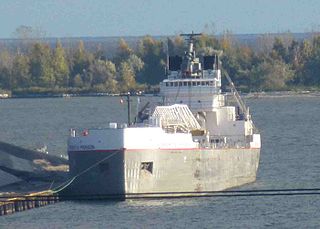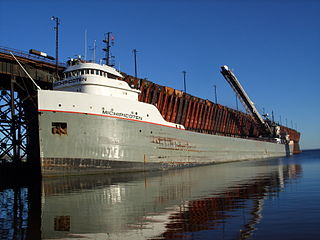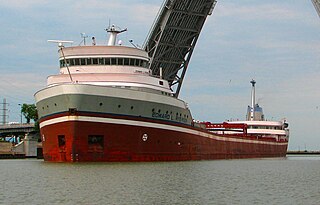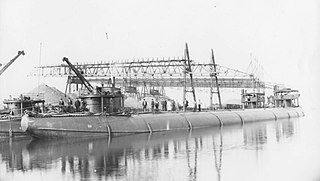
A straight decker is a ship built with its pilothouse forward and engines aft to provide a continuous hold in between. This design originated to meet the navigational demands on lake freighters on the U.S./Canadian Great Lakes routes. The term "Straight Decker" is commonly used upon the Great Lakes to denote a bulk/ore freighter which has not been equipped with self-unloading machinery.

Lake freighters, or lakers, are bulk carrier vessels that ply the Great Lakes of North America. These vessels are traditionally called boats, although classified as ships.

SS Arthur M. Anderson is a cargo ship of the laker type. She is famous for being the last ship to be in contact with SS Edmund Fitzgerald before Edmund Fitzgerald sank on 10 November 1975. Arthur M. Anderson was also the first rescue ship on the scene in a vain search for Edmund Fitzgerald survivors. The vessel's namesake, Arthur Marvin Anderson, was director of U.S. Steel, a member of its finance committee and vice chairman of J.P. Morgan & Co. at the time. The ship was launched in 1952 and is in active service.

An ore dock is a large structure used for loading ore onto ships, which then carry the ore to steelworks or to transshipment points. Most known ore docks were constructed near iron mines on the upper Great Lakes and served the lower Great Lakes. Ore docks still in existence are typically about 60 feet (18 m) wide, 80 feet (24 m) high, and vary from 900 feet (270 m) to 2,400 feet (730 m) in length. They are commonly constructed from wood, steel, reinforced concrete, or combinations of these materials.

Hennepin is a shipwreck off the east coast of Lake Michigan, west of South Haven, Michigan. The ship was originally built in October 1888 and sank on August 18, 1927. Michigan Shipwreck Research Associates found the ship in 2006 and conducted several dives to assess the condition of the wreck. The wreck was listed on the National Register of Historic Places on February 1, 2008. She is significant as the first self-unloading bulk carrier.

The American Steamship Company (ASC) is an American transportation company that operates a fleet of self-unloading vessels in the Great Lakes. The company is owned by the General American Transportation Corporation (GATX).

MV Paul R. Tregurtha is a Great Lakes-based bulk carrier freighter. She is the current Queen of the Lakes, an unofficial but widely-recognized title given to the longest vessel active on the Great Lakes. Launched as William J. De Lancey, she was the last of the 13 "thousand footers" to enter service on the Great Lakes, and was also the last Great Lakes vessel built at the American Ship Building Company yard in Lorain, Ohio.

MV American Integrity is a ship built in 1978 by Bay Shipbuilding Company in Sturgeon Bay, Wisconsin. She is one of the thirteen 1,000 footers in the Great Lakes laker fleet. She was originally built as Lewis Wilson Foy and was renamed Oglebay Norton in 1991. She was renamed again after the sale to American Steamship Company in June, 2006. On September 24, 2017 the American Integrity broke the all-time record for the largest load through the Soo Locks with 75,095 tons of iron ore beating the record held for the last two weeks by the Edwin H. Gott. She was loaded to a draft of 29'7" on her way to Indiana Harbor.

The Robert S. Pierson is a bulk carrier built for and operated on the North American Great Lakes. The vessel went through several owners and several names. In 2007 she was sold to Lower Lakes Towing, a Canadian company. Her last namesake was Robert Scott Pierson, the founder of the shipping firm Soo River Company. An earlier vessel named after Pierson operated from 1980 to 1982.

The SS St. Marys Challenger is a freight-carrying vessel operating on the North American Great Lakes built in 1906. Originally an ore boat, she spent most of her career as a cement carrier when much larger ore boats became common. After a 107-year-long working career as a self-propelled boat, she was converted into a barge and paired with the tug Prentiss Brown as an articulated tug-barge. Before conversion, she was the oldest operating self-propelled lake freighter on the Great Lakes, as well as being one of the last freight-carrying vessels on the Great Lakes to be powered by steam engines.

Bay Shipbuilding Company (BSC) is a shipyard and dry dock company in Sturgeon Bay, Door County, Wisconsin. As of 2015, Bay Ships was a subsidiary of Fincantieri Marine Group and produces articulated tug and barges, OPA-90 compliant double hull tank ships and offshore support vessels. It also provides repair services to the lake freighter fleet. In the past the shipyard located in Sturgeon Bay has operated under several different names and traces its history back to 1918. The company also built 40,000 ton Lake freighters in the 1970s and 1980s. While capable of producing large freighters, the yard has not built a freighter over 20,000 tons since 1987. Former names of the shipyards at the 2015 location of Bay Shipbuilding are: Sturgeon Bay Shipbuilding, Leathem D. Smith Shipbuilding Company and Christy Corporation.
M/V American Century is a very large diesel-powered Lake freighter owned and operated by the American Steamship Company. This vessel was built in 1981 at Bay Shipbuilding Company, Sturgeon Bay, Wisconsin and included self-unloading technology.
The Interlake Steamship Company is an American freight ship company that operates a fleet on the Great Lakes in North America.

The Frank C. Ball was an American Bulk carrier that was built by the Great Lakes Engineering Works of Ecorse, Michigan, for the Globe Steamship Company of Duluth, Minnesota. She was launched on December 9, 1905 as hull #14. She was powered by a 1,700 horsepower triple expansion steam engine and fueled by two coal-fired Scotch marine boilers. Even though Ball was built in 1905, she only entered service in 1906.

The Australasia was a wooden hulled American Great Lakes freighter that served on the Great Lakes of North America between her construction in 1884 to her burning and sinking in 1896. On October 18, 1896 while loaded with coal, the Australasia sank in Lake Michigan near the town of Sevastopol, Door County, Wisconsin, United States, after burning off Cana Island. On July 3, 2013 the wreck of the Australasia was added to the National Register of Historic Places.

The MV Kaye E. Barker is a self-discharging lake freighter owned and operated by the Interlake Steamship Company. She was originally built as the Edward B. Greene, and was later renamed Benson Ford before being sold to Interlake and named the Barker. It primarily hauls taconite pellets, stone, and coal across the North American Great Lakes.

Michipicoten is a self-discharging lake freighter owned and operated by Canadian shipping firm Lower Lakes Towing. Michipicoten primarily hauls taconite from Marquette, Michigan to the Algoma Steel Mill in Sault Ste. Marie, Ontario. It has a capacity of 22,300 tons, a speed of 12 knots (14 mph), and a length of 689 feet 6 inches (210.2 m).

Joseph H. Thompson was built as the Marine Robin, in Chester, Pennsylvania, for the US Maritime Commission, in 1944, for service in World War II.

SS Edward L. Ryerson is a steel-hulled American Great Lakes freighter built in 1960. Throughout her career on the Great Lakes, she has been laid up multiple times. Ever since 2009, she has been in long term layup at the Fraser Shipyard in Superior, Wisconsin. She is one of only two American-owned straight deck lake freighters, the other one being 1958-built freighter John Sherwin.

115 was an American whaleback barge in service between 1891 and 1899. She was built between May and August 1891, in Superior, Wisconsin by Alexander McDougall's American Steel Barge Company, for the "McDougall fleet", based in Buffalo, New York. She was one of a class of distinctive, experimental ship designed and built by McDougall. The whalebacks were designed to be more stable in high seas. They had rounded decks, and lacked the normal straight sides seen on traditional lake freighters. 115 entered service on August 25, hauling iron ore from Superior.

















